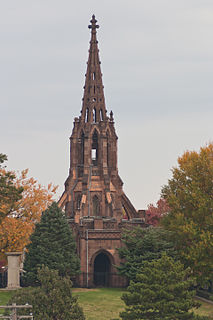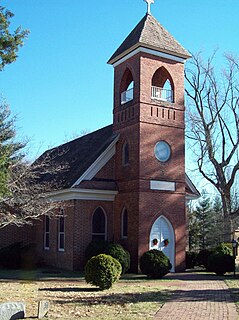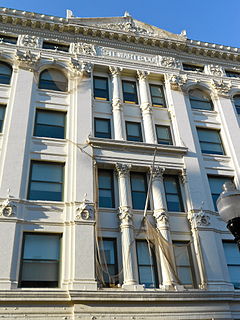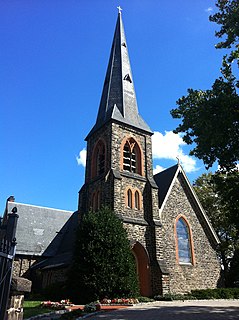
Reisterstown is an unincorporated community and census-designated place in Baltimore County, Maryland, United States. As of the 2010 census, it had a population of 25,968.
Robert Cary Long Jr. (1810–1849) was the son of a late 18th Century - early 19th Century famous architect Robert Cary Long Sr. of Baltimore, Maryland and was himself a well-known 19th Century architect. Like his father, Cary was based in Baltimore.

John Rudolph Niernsee was an American architect. He served as the head architect for the Baltimore and Ohio Railroad. Rudolph also largely contributed to the design and construction of the South Carolina State House located in Columbia, South Carolina. Along with his partner, James Crawford Neilson, Rudolph established the standard for professional design and construction of public works projects within Baltimore and across different states in the United States.

St. Paul's Episcopal Church is a parish of the Episcopal Church near Point of Rocks, Frederick County, Maryland, in the Episcopal Diocese of Maryland. It is noted for its historic parish church, a small late Federal style brick structure built in 1842.

St. Thomas' Church is an Episcopal church in a rural setting, located at Croom, Prince George's County, Maryland. It is one of four congregations that have constituted the parish of St. Thomas in the Episcopal Diocese of Washington, the others including the Church of the Atonement in Cheltenham, the Chapel of the Incarnation in Brandywine, and St. Simon's Mission also in Croom.

Middleham Chapel is a historic Episcopal church located in Lusby, Calvert County, Maryland. It is a one-story, cruciform, Flemish bond brick structure with exposed fieldstone foundations. It was built in 1748, to replace an earlier frame or log structure believed to have been erected as early as 1684, as a Chapel of Ease of Christ Church Parish. The date of construction is worked into the brick on the front of the church.

The Epiphany Chapel and Church House is a historic church at Odenton, Anne Arundel County, Maryland, United States. It is a two-story gable-roofed frame building constructed in 1918 and laid out in cruciform plan in the Arts and Crafts style. It is significant for its association with the mobilization of the United States military for World War I, since it was constructed adjacent to Camp Meade, a major training camp for troops bound for the Western Front in Europe. Its design was an early work of the prominent Baltimore architect Riggin T. Buckler (1882-1955) of the partnership/firm of Sill, Buckler & Fenhagen.

St. Bartholomew's Episcopal Church, also known as Green Hill Church, is a historic Episcopal church located near Quantico in Wicomico County, Maryland.

St. Thomas' Episcopal Church is a parish of the Episcopal Church in Owings Mills, Baltimore County, Maryland, part of the Diocese of Maryland. It is noted for its historic parish church, built in 1743.

St. James Church is a historic Episcopal church located at Monkton, Baltimore County, Maryland, US.

St. John's Chapel of St. Michael's Parish is a historic Episcopal church at Easton, Talbot County, Maryland. It is a granite Gothic Revival ruin. The building measures 35 feet wide and 50 feet deep. The chapel was built in about 1835 and abandoned around 1895.
Montrose Mansion and Chapel, originally known as Montrose Mansion, is a historic home located on the campus of Camp Fretterd Military Reservation of the Maryland Army National Guard in Reisterstown, Baltimore County, Maryland. It is a two-story neoclassical stone house constructed originally about 1826 by William Patterson who gave it to his grandson, Jerome Napoleon Bonaparte as a wedding present. By the middle of the 19th century, a large two-story wing was added, then a mansard roof with round-top dormers, a cupola, and a bracketed cornice with pendants was added about 1880. The chapel was completed in 1855 and is a rectangular structure of stone with Greek Revival decorative detailing. It features a three-story bell and entrance tower.

St. Andrew's Episcopal Chapel is an historic Episcopal chapel located at Sudlersville, Queen Anne's County, Maryland, built as a chapel of ease for St. Luke's Church in Church Hill. It was listed on the National Register of Historic Places in 1984.

Stewart's Department Store, also known as the Posner Building, is a historic department store building located on Howard Street at Baltimore, Maryland, United States. Catholic Relief Services is currently headquartered there.

Lovely Lane United Methodist Church, formerly known as First Methodist Episcopal Church, and earlier founded as Lovely Lane Chapel is a historic United Methodist church located at Baltimore, Maryland, United States.

St. John's Episcopal Church, also known as St John's in the Village, is a nineteenth-century Episcopal church building on Old York Road in the former village of Huntingdon (now the community of Waverly in northeast Baltimore, Maryland, United States. The congregation is often referred to as "St. John's of Huntingdon Episcopal Church". It is a Gothic Revival structure built originally in 1847. Also on the property is a cemetery.

Green Spring Valley Historic District is a national historic district near Stevenson in Baltimore County, Maryland, United States. It is a suburban area of Baltimore that acquires significance from the collection of 18th, 19th, and early 20th century buildings. The park-like setting retains a late 19th-early 20th century atmosphere. At the turn of the 20th century, the Maryland Hunt Cup and the Grand National Maryland steeplechase races were run over various parts of the valley. The Maryland Hunt Cup, which began as a competition between the Green Spring Valley Hunt and the Elkridge Hunt, traditionally started at Brooklandwood, the previous home of Charles Carrol of Carrollton with the finish across Valley Road at Oakdene, at that time the home of Thomas Deford, which remains a private residence

Reisterstown Historic District is a national historic district in Reisterstown, Baltimore County, Maryland, United States. Its development is inseparably identified with the roads that converge to form Main Street. They are Maryland Route 30 and Maryland Route 140. The earliest structures, including several of log, date to the late 18th century, although the town was founded in 1758. It developed as a convenient stopping place for weary travelers from the outer reaches of Western Maryland or Pennsylvania and many businesses catered to the traveler: including taverns and inns, smithshops, saddleries, stables, waggoners.

John W. Priest (1825-1859) was a noted American architect from New York and founding member of the American Institute of Architects.

Glyndon is an unincorporated community in Baltimore County, Maryland, United States. Founded in 1871 by Dr. Charles A. Leas, the village is located in the northwest section of Baltimore County and is primarily a residential suburb of metropolitan Baltimore City. The village is characterized by the predominance of historic Victorian homes and a strong sense of community among its residents. Glyndon is listed on the National Register of Historic Places (1973) and on the Maryland Inventory of Historic Properties (1973); the Glyndon Historic District was also designated as the first historic district in Baltimore County (1981).























